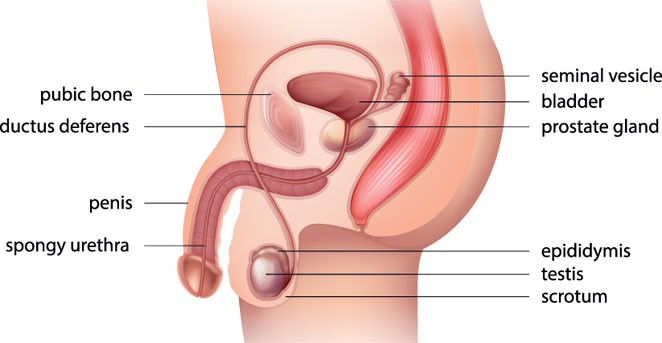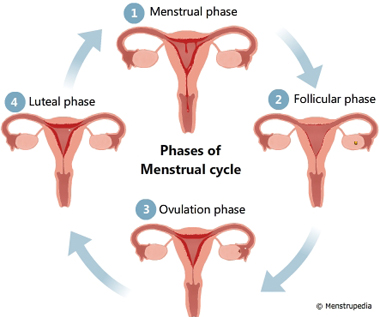Reproduction in human beings is by sexual reproduction where both the male and female gametes fertilize to give rise to an embryo. The fertilization of human embryo occurs inside the body of the female. Thus, it is called Internal Fertilization. Human Beings are viviparous organisms who give rise to Embryos directly instead of laying eggs. Let us understand a little more about the male and female reproductive organs and the process of fertilization in them.
Suggested Videos
Male Reproductive System

Image Source: plannedparenthood
- Testes: Male humans have two testes. They are situated in a bag of skin known as the scrotum. Scrotum lies outside the pelvic cavity.
- Sperm Duct: These are thin ducts that arise from the testes.
- Prostrate Gland: This gland is an accessory gland in males which pours its secretions into the sperm duct along with the seminal fluid from the testes and into the penis.
- Urethra: Functions as a common pathway for the seminal fluid and urine in males. It is longer in males and shorter in females.
- Penis: Is an organ which lies outside the body and functions to eliminate both urine and semen.
The testes are the primary organs of male reproduction. They are responsible for producing the male gamete known as the sperm by a process called as spermatogenesis. This occurs in the seminiferous tubules of the testes. The testes are also responsible for secreting the male reproductive hormone testosterone.
Laydig Cells of the testes synthesizes Testosterone. The hormone testosterone not only helps in the formation of the sperm but also in the development of secondary sexual characters in males such as deepening of the voice, facial and pubic hair during puberty.
Female Reproductive System

Image Source: s-cool.co.uk
The female reproductive system in humans in entirely within the pelvic cavity. It comprises of the following structures:
- Ovaries: They give rise to the female gamete or the egg. Each ovary releases one egg alternatively each month. Ovulation is the process of release of an egg from either one of the ovaries.
- Fallopian tubes: Also known as the oviducts, these tubes arise from the ovaries and end at the uterine fundus. Their function is to carry the egg once it is released into the uterus where it can fuse with the male sperm.
- Uterus: It is a large muscular organ that is present in the pelvic cavity. The uterus is the region of action during the menstrual cycle, fertilization and the development of the fetus.
- Cervix: Is a circular muscle ring that is present towards the lower end of the uterus that dilates at the time of delivery of the baby.
- Vagina: Is a muscular tube-like structure that is present at the lower end of the cervix and leads towards the outside of the female body. The vagina functions as the pathway for the penis to enter the female body and deposit the sperms which then swim their way to the uterus to fertilize with the female egg.
- Urethra: It is shorter than that found in males. In females, the urethra serves only for passage of urine.
The egg is formed under the influence of both female sex hormones estrogen and progesterone. This process is known as Oogenesis.
Process of Fertilisation and Further Development

Image Source: open.edu
The male gametes i.e the sperms are deposited in the female body by the process called as sexual intercourse. Once the sperms are deposited in the vagina, they need to travel upwards to reach the egg that is released from the ovaries and picked up by the fallopian tubes. When the sperm meets the egg, it needs to penetrate through its layers to cause fertilization. Both the Egg and the Sperm fertilize and form the diploid zygote.
Each parent provides 23 chromosomes at the initial fertilization. Thus, the zygote contains double the number of chromosomes (46). It is called diploid. Once this happens, zona pellucida from the egg forms a thick layer around the zygote to prevent more than one sperm to fertilize the egg. this zygote now forms into a morula and then into a blastocyst. It then develops chorionic villi from the outer layer of the blastocyst known as the chorion.
These villi attach themselves to the inner wall of the uterus. Implantation is the process of attachment of the embryo to the uterine wall. The tissues between the growing embryo and the mother’s uterine walls form the placenta. Placenta functions to provide nutrition to the embryo until its birth. The hormones estrogen and progesterone both help in maintaining the placenta and the fetus inside the uterus. The normal gestation period for humans is 38 weeks which is a little over 9 months.
At the end of this term, the uterine contractions begin under influence of hormones. A major hormone that plays a role in this is oxytocin. It affects the cervix and causes it to dilate to allow the baby to pass outside the body of the mother. The umbilical cord with its blood vessels and the placenta are also expelled along with the baby.
The mother’s hormones come back to normalcy from the next menstrual cycle.
Menstrual Cycle

Image Source: menstrupedia.com
This is a biological process that occurs in human females from the time they attain puberty. When a girl child is born, the primary oocytes already occur. When the child reaches puberty, the process of meiosis continues to give rise to the secondary oocyte. This secondary oocyte is released from each ovary alternatively in every alternate month.
Each ovary releases this secondary oocyte alternative The fallopian tube picks it up and transports it to the uterus. The surface of the ovary that has released the egg is called the corpus luteum. It releases progesterone. If the egg doesn’t fertilize, the corpus luteum disintegrates after 14 days and the progesterone levels fall.
This causes disintegration of the uterine lining which is called menses or the monthly cycle. If fertilization occurs, the corpus luteum stays and no shedding of the uterine lining occurs. The uterus prepares for the implantation of the fetus.
Learn more about Sexual Reproduction in Flowering Plants.
Solved Example for You
Question: The corpus luteum releases which hormone?
- Oxytocin
- Progesterone
- Estrogen
- Testosterone
Solution: Option B Progesterone. The corpus luteum releases progesterone. If fertilization does not occur, the corpus luteum disintegrates. If fertilization occurs, the corpus luteum stays.







Leave a Reply